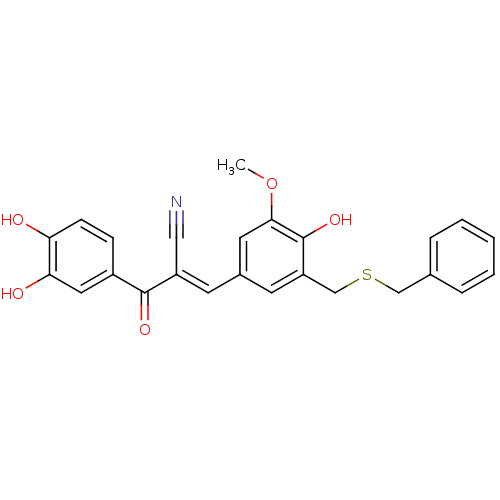BDBM50036678 3-(3-Benzylsulfanylmethyl-4-hydroxy-5-methoxy-phenyl)-2-(3,4-dihydroxy-benzoyl)-acrylonitrile::CHEMBL116547
SMILES COc1cc(\C=C(/C#N)C(=O)c2ccc(O)c(O)c2)cc(CSCc2ccccc2)c1O
InChI Key InChIKey=SMPHSAOFBCCNMS-DJKKODMXSA-N
Data 4 IC50
Activity Spreadsheet -- Enzyme Inhibition Constant Data from BindingDB
 Found 4 hits for monomerid = 50036678
Found 4 hits for monomerid = 50036678
TargetEpidermal growth factor receptor(Homo sapiens (Human))
Hebrew University Of Jerusalem
Curated by ChEMBL
Hebrew University Of Jerusalem
Curated by ChEMBL
Affinity DataIC50: 750nMAssay Description:Inhibitiory concentration against EGF receptor by polyGAT phosphorylationMore data for this Ligand-Target Pair
TargetEpidermal growth factor receptor(Homo sapiens (Human))
Hebrew University Of Jerusalem
Curated by ChEMBL
Hebrew University Of Jerusalem
Curated by ChEMBL
Affinity DataIC50: 2.00E+3nMAssay Description:Inhibition of HER-14 (human EGFR overexpressing NIH3T3) cell proliferationMore data for this Ligand-Target Pair
TargetEpidermal growth factor receptor(Homo sapiens (Human))
Hebrew University Of Jerusalem
Curated by ChEMBL
Hebrew University Of Jerusalem
Curated by ChEMBL
Affinity DataIC50: 4.50E+3nMAssay Description:Inhibitiory concentration against EGF receptor by polyGAT phosphorylationMore data for this Ligand-Target Pair
TargetEpidermal growth factor receptor/Receptor tyrosine-protein kinase erbB-2(Homo sapiens (Human))
Hebrew University Of Jerusalem
Curated by ChEMBL
Hebrew University Of Jerusalem
Curated by ChEMBL
Affinity DataIC50: 6.20E+3nMAssay Description:Inhibition of HER-14 (human EGFR overexpressing NIH3T3) cell proliferationMore data for this Ligand-Target Pair
